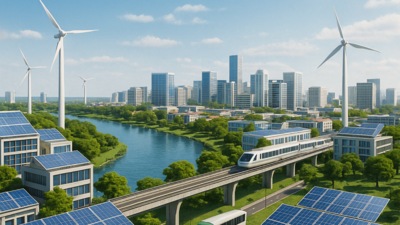- News
- City News
- amaravati News
- Amaravati to be world's first fully renewable-powered city
Trending
Amaravati to be world's first fully renewable-powered city
Amaravati is poised to become the world's first city powered entirely by renewable energy, aiming for 2,700 MW of clean energy from solar, wind, and hydropower. This ambitious project, driven by Chief Minister Naidu's vision, supports India's clean energy goals. The city will mandate rooftop solar and implement green building standards, targeting a sustainable, future-ready capital.
NEW DELHI: Amaravati is set to make history by aiming to become the world’s first city powered entirely by renewable energy. The planned greenfield city is being developed as a modern, sustainable ‘people’s capital’, with a goal to generate 2,700 megawatts (MW) of clean energy from solar, wind, and hydropower sources, officials said.
The ambitious project is part of chief minister N Chandrababu Naidu’s vision and supports India’s larger push towards clean energy and climate responsibility. Prime Minister Narendra Modi is expected to lay the foundation stone for the new capital this month. The project, with an estimated cost of Rs 65,000 crore, will span 217 square kilometres along the banks of the Krishna River. The wider Andhra Pradesh Capital Region covers around 8,352 sq km.
Located between Vijayawada and Guntur, Amaravati is set to become a model of innovation in eco-friendly urban design. Planners aim to position the city as a global example in sustainable urban growth by relying entirely on green energy. The 2,700 MW power capacity target would eliminate the need for fossil fuels and place Amaravati at the forefront of environmentally responsible city planning.
By 2050, Amaravati is projected to need 2.7 gigawatts of electricity. At least 30 per cent of this will be sourced from renewable energy like solar and wind. Solar energy will be a key focus, with mandatory rooftop solar systems required on at least one-third of all roofs in government housing projects. These conditions have been made part of the building approval process,
“All major building projects, including the government housing in the Amaravati Government Complex, will adhere to green building standards, ensuring energy efficiency, reduced carbon footprint, and optimal resource utilisation,” they said.
The city's public transport system, including the Amaravati Metro and electric buses, will also run on renewable energy. Widespread infrastructure will be developed for electric vehicle charging across both public and government sectors.
Additionally, solar panels will be explored for installation in public spaces such as parks, walkways, and bus stops.
“Amaravati is being built as a sustainable, future-ready capital city with a strong emphasis on renewable energy and energy-efficient infrastructure,” an official said.
Town planners have already set up 415 kW of rooftop solar systems in 16 Anganwadis, 14 e-health centres, 13 public schools, and a multi-faith funeral facility.
“All government and commercial buildings will be mandated to install solar panels and adopt net metering,” he said. “A district cooling system is being planned for government complexes to optimise energy use and reduce cooling demands.”
With Andhra Pradesh experiencing the highest number of heatwave days in South India and temperatures reaching up to 47.7 degrees Celsius in 2024, efficient cooling systems are essential. Cooling needs include those for air-conditioning, refrigeration, transport, and industrial purposes.
The state expects its peak power demand to rise by 57 per cent, reaching 19.9 GW by 2029. To address cooling requirements in a sustainable way, the Andhra Pradesh Capital Region Development Authority (APCRDA) signed a public-private partnership with Tabreed in 2019. This agreement aims to set up a 20,000 refrigeration tonnes (RT) District Cooling System for the government complex in Amaravati.
Under this agreement, Tabreed will design the system to reduce electricity demand for cooling key buildings like the High Court and Secretariat by 50 per cent.
District Cooling technology helps reduce the need for separate cooling systems in individual buildings, thereby lowering overall power consumption and carbon emissions.

About the Author
TOI City DeskEnd of Article
Follow Us On Social Media









